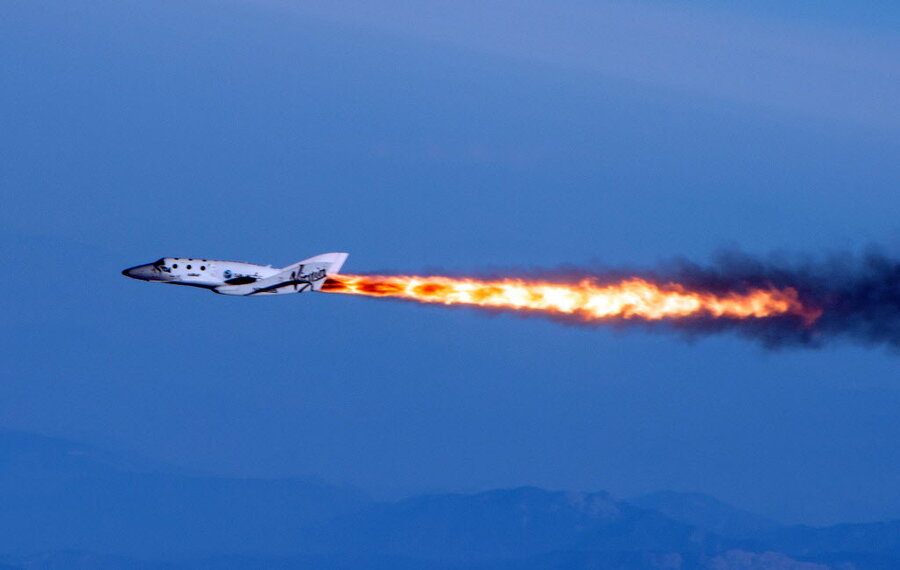Virgin Galactic releases footage from supersonic flight
After a successful sound-barrier-smashing test flight, Virgin Galactic has released footage from a camera on its prize spaceship’s tail. The view, though not as extraordinary as the one that future ticketed passengers can expect to see as they float at the craft’s windows, is a white-knuckle-inducing one of a plume of fire and a distant desert below.
SpaceShipTwo, or SS2, Virgin Galactic’s supersonic spacecraft built for suborbital tourism, made its second rocket powered test flight and 29th free flight last week. The flight began at about 8 a.m. on Thursday, when the company’s WhiteKnightTwo carrier aircraft lifted off from the Mojave Air and Space Port, in the Southwestern US’s Mojave Desert, with SS2 in tow.
At an altitude of 46,000 feet, SS2 was released, like prey spared from an eagle’s claws, and pilots Mark Stucky and Clint Nichols ignited the rocket. For 20 seconds, the orange-black plume propelled the spaceship to 69,000 feet and to a maximum speed of Mach 1.43 – or supersonic speed, faster than the speed of sound. In the video, overlaid with audio from the craft’s cockpit, the two pilots’ voices strain in counting down the seconds of powered flight.
The mission then wrapped up with a test of the SS2’s feather system, a slowing mechanism designed to smoothly bring the craft back to Earth and a first for a rocket-powered flight. The total flight time was about 1 hour and 25 minutes.
Virgin Galactic, owned by Richard Branson’s Virgin Group and Aabar Investments, the Abu Dhabi joint stock company, is often credited with pioneering a still-limited market for space tourism, and SS2 is considered the front-runner to be the world’s first commercial spacecraft. If all goes well in future tests, the company expects that SS2 will be lofting passengers into space in about one year – though the company had said back in 2005 that 2007 was the target date for commercial operations to begin.
SS2’s speed and altitude are unusual per the standards of standard plane travel – the average commercial jet flies at about 30,000 feet and at about 550 miles per hour, or Mach 0.84 (subsonic). But those numbers are not yet at planned, commercial-ready levels. SS2’s 69,000 foot altitude puts it in the stratosphere, the second highest of the atmosphere’s four thermal zones, which means that it is some 260,000 feet below what is called the Kármán line, where the World Air Sports Federation defines space as beginning.
To reach that Kármán line, SS2 will have to reproduce the success of the company’s previous craft, SpaceShipOne. That ship reached 367,442 feet (69.6 miles) in 2004, booming into space and winning its maker the $10 million Ansari X Prize. But SS1 was not commercially viable, with room for just two passengers and one pilot, the company had said. The new, roomier craft seats six and has space for two pilots, as well as two large windows per passenger (“No more squabbling over who has the best seat!” the company says on its website.)
This was the second test flight for SS2, putting the craft at its highest altitude and fastest speed yet. In April, the ship had delighted potential space tourists when it made its first rocket-powered flight, smashing the sound barrier at 1.2 Mach and at 55,000 feet, in a spectacular demonstration of what an business magnate's money could buy.
After landing, California Gov. Arnold Schwarzenegger and New Mexico Gov. Bill Richardson toasted what Mr. Branson called “the sexiest ship ever” by cracking champagne bottles on the craft’s nose. Virgin Galactic also celebrated with a price uptick, raising the cost of seat on the craft from $200,000 to $250,000.
So far, Justin Bieber, Angelina Jolie, Brad Pitt, Ashton Kutcher, and Tom Hanks have all booked rides in the craft. And they are not alone: The company reports that it has accepted $70 million in deposits from approximately 580 people for its spaceflights since it began selling spots in 2005.
A ticket purchases membership in “perhaps the world's most exclusive club with privileged access to all aspects of the project as it progresses,” the company says. Besides that, ticket-holders can expect, after a physical and three days of training, “an out-of-the-seat, zero-gravity experience with astounding views of the planet from the black sky of space.”
Plus, “later that evening, sitting with your astronaut wings, you know that life will never quite be the same again,” the company says.
Flights are to depart from New Mexico’s Spaceport America, a sleek, 24-acre complex under construction at a cost of $209 million to the state. SpaceX, the spaceflight start-up, began using the port this spring to test the Grasshopper, a reusable rocket.







